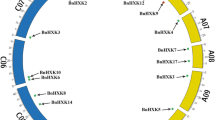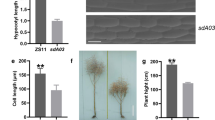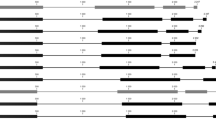Abstract
High throughput screening of stage-specific differentially expressed genes in a Brassica napus two-line Rs1046A/B subtractive library was used to identify the BnQRT3 gene associated with cell wall metabolism. Phylogenetic analysis indicates the protein product of BnQRT3 is polygalacturonase. According to cytological comparisons of Rs1046 sterile and fertile anthers, RT–PCR studies and in situ hybridizations, BnQRT3 is expressed most strongly in floral organs and may play an essential role in pollen maturation. Analysis of the histological staining pattern of BnQRT3 promoter-GUS constructs in transgenic Arabidopsis and Brassica napus revealed that proximal part of 5′-flanking region directed expression in the vascular tissue of filaments, veins in sepal and petals, stigma, branch connective and the floral organ abscission zone during the open flower stage. In the meanwhile, Activity of BnQRT3 was detected in the anthers, which commences at the microsporocyte stage and persists as anther approaches dehiscence. Strong GUS expression also can be observed in the vascular tissue of leaves and stem by compression with forceps or excision, suggesting that the BnQRT3 promoter is responsive to wounding.







Similar content being viewed by others
References
Yang CY, Vizcay-Barrena G, Conner K, Wilson ZA (2007) Male sterility1 is required for tapetal development and pollen wall biosunthesis. Plant Cell 19:3530–3548
Scott RJ, Spielman M, Dickinson HG (2004) Stamen structure and function. Plant Cell 16(Suppl 1):S46–S60
Sanders PM, Bui AQ, Weterings K, McIntire KN, Hsu Y-C, Lee PY, Truong MT, Beals TP, Goldberg RB (1999) Anther developmental defects in Arabidopsis thaliana male-sterile mutants. Sex Plant Reprod 11:297–322
Ma H (2005) Molecular gentic analysis of microsporogenesis and microgametogenesis in flowering plants. Ann Rev Plant Biol 56:393–434
Deng W, Zhou L, Zhou YT, Wang YJ, Wang ML, Zhao Y (2010) Isolation and characterization of three duplicated PISTILLATA genes in Brassica napus. Mol Biol Rep DOI 10.1007/s11033-010-9981-9
Parkin IAP, Sharpe AG, Lydiate DJ (2003) Patterns of genome duplication within the Brassica napus genome. Genome 46:291–303
Huang L, Cao JS, Zhang AH, Ye YQ (2008) Characterization of a putative pollen-specific arabinogalactan protein gene, BcMF8, from Brassica campestris ssp. Chinensis. Mol Biol Rep 35:631–639
Song JH, Zhang LX, Cao JS (2009) Molecular cloning and characterization of a novel pollen predominantly membrane protein gene BcMF12 from Brassica campestris ssp. Chinensis. Mol Biol Rep 36:2307–2314
Li YY, Cao JS (2009) Morphological and functional characterization of BcMF13 in the antisense-silenced plants of Brassica campestris ssp. chinensis var. parachinensis. Mol Biol Rep 36:929–937
Carlsson J, Lagercrantz U, Sundstrom J, Teixeira R, Wellmer F, Meyerowitz EM, Glimelius K (2007) Microarray analysis reveals altered expression of a large number of nuclear genes in developing cytoplasmic male sterile Brassica napus flowers. Plant J 49:452–462
Kang J, Zhang G, Bonnema G, Fang Z, Wang X (2008) Global analysis of gene expression in flower buds of Ms-cd1 Brassica oleracea conferring male sterility by using an Arabidopsis microarray. Plant Mol Biol 66:177–192
Wu JY, Shen JR, Mao XZ, Liu KD, Wei LP, Liu PW, Yang GS (2007) Isolation and analysis of differentially expressed genes in dominant genic male sterility (DGMS) Brassica napus L. using subtractive PCR and cDNA microarray. Plant Sci 172:204–211
Kumar S, Tamura K, Nei M (2004) MEGA3: integrated software for molecular evolutionary genetics analysis and sequence alignment. Brief Bioinformatics 5:150–163
Kouchi H, Hata S (1993) Isolation and characterization of novel nodulin cDNAs representing genes expressed at early stages of soybean nodule development. Mol Gen Genet 238:106–119
Mizuno S, Osakabe Y, Maruyama K, Ito T, Osakabe K, Sato T, Shinozaki K, Yamaguchi-Shinozaki K (2007) Receptor-like protein kinase 2 (RPK2) is a novel factor controlling anther development in Arabidopsis thaliana. Plant J 50:751–766
Cardoza V, Stewart CN (2003) Increased Agrobacterium-mediated transformation and rooting efficiencies in canola (Brassica napus L.) from hypocotyl segment explants. Plant Cell Rep 21:599–604
Sessions A, Weigel D, Yanofsky MF (1999) The Arabidopsis thaliana MERISTEM LAYER 1 promoter specifies epidermal expression in meristems and young primordia. Plant J 20:259–263
Hadfield KA, Bennett AB (1998) Polygalacturonases: many genes in search of a function. Plant Physiol 117:337–343
Torki M, Mandaron P, Thomas F, Quigley F, Mache R, Falconet D (1999) Differential expression of a polygalacturonase gene family in Arabidopsis thaliana. Mol Gen Genet 261:948–952
Lescot M, Dehais P, Thijs G, Marchal K, Moreau Y, Van de Peer Y, Rouze P, Rombauts S (2002) PlantCARE, a database of plant cis-acting regulatory elements and a portal to tools for in silico analysis of promoter sequences. Nucl Acids Res 30:325–327
Higo K, Ugawa Y, Iwamoto M, Korenaga T (1999) Plant cis-acting regulatory DNA elements (PLACE) database. Nucl Acids Res 27:297–300
Bate N, Twell D (1998) Functional architecture of a late pollen promoter: pollen-specific transcription is developmentally regulated by multiple stage-specific and co-dependent activator elements. Plant Mol Biol 37:859–869
Rogers H, Bate N, Combe J, Sullivan J, Sweetman J, Swan C, Lonsdale D, Twell D (2001) Functional analysis of cis-regulatory elements within the promoter of the tobacco late pollen gene g10. Plant Mol Biol 45:577–585
Meshi T, Taoka KI, Iwabuchi M (2000) Regulation of histone gene expression during the cell cycle. Plant Mol Biol 43:643–657
Van Der Straeten D, Rodrigues-Pousada RA, Goodman HM, Van Montagu M (1991) Plant enolase: gene structure, expression, and evolution. Plant Cell 3:719–735
Gubler F, Jacobsen JV (1992) Gibberellin-responsive elements in the promoter of a barley high-pl a-amylase gene. Plant Cell 4:1435–1441
Mena M, Vicente-Carbajosa J, Schmidt RJ, Carbonero P (1998) An endosperm-specific DOF protein from barley, highly conserved in wheat, binds to and activates transcription from the prolamin-box of a native B-hordein promoter in barley endosperm. Plant J 16:53–62
Lin X, Feng XH, Watson JC (1991) Differential accumulation of transcripts encoding protein kinase homologs in greening pea seedlings. Proc Natl Acad Sci USA 88:6951–6955
Taylor JE, Webb STJ, Coupe SA, Tucker GA, Roberts JA (1993) Changes in polygalacturonase activity and solubility of polyuronides during ethylene-stimulated leaf abscission in Sambucus nigra. J Exp Bot 44:93–98
Bonghi C, Rascio N, Ramina A, Casadoro G (1992) Cellulase and polygalacturonase involvement in the abscission of leaf and fruit explants of peach. Plant Mol Biol 20:839–848
Meakin PJ, Roberts JA (1991) Anatomical and biochemical changes associated with the induction of oilseed rape (Brassica napus) pod dehiscence by Dasineura brassicae (Winn.). Ann Bot 67:193–197
Pressey R (1991) Polygalacturonase in tree pollens. Phytochemistry 30:1753–1755
Pressey R, Reger BJ (1989) Polygalacturonase in pollen from corn and other grasses. Plant Sci 59:57–62
Koltunow AM, Truettner J, Cox KH, Wallroth M, Goldberg RB (1990) Different temporal and spatial gene expression patterns occur during anther development. Plant Cell 2:1201–1224
Paul W, Hodge R, Smartt S, Draper J, Scott R (1992) The isolation and characterization of the tapetum-specific Arabidopsis thaliana A9 gene. Plant Mol Biol 19:611–622
Yokoi S, Tsuchiya T, Toriyama K, Hinata K (1997) Tapetum specific expression of the Osg6B promoter-β-glucuronidase gene in transgenic rice. Plant Cell Rep 16:363–367
Roberts MR, Foster GD, Blundell RP, Robinson SW, Kumar A, Draper J, Scott R (1993) Gametophytic and sporophytic expression of an anther-specific Arabidopsis thaliana gene. Plant J 3:111–120
Xu HL, Davies SP, Kwan BYH, Obrien AP, Singh M, Knox RB (1993) Haploid and diploid expression of a Brassica campestris anther-specific gene promoter in Arabidopsis and tobacco. Mol Gen Genet 239:58–65
Shiba H, Takayama S, Iwano M, Shimosato H, Funato M, Nakagawa T, Che FS, Suzuki Go, Watanabe M, Hinata K, Isogai A (2001) A pollen coat protein, SP11/SCR, determines the pollen S-specificity in the self-incompatibility of Brassica species. Plant Physiol 125:2095–2103
Gόmez MD, Beltrάn JP, Cañas LA (2004) The pea END1 promoter drives anther-specific gene expression in different plant species. Planta 219:967–981
Roque E, Gomez MD, Ellul P, Wallbraun M, Madueno F, Beltran JP, Canas LA (2007) The PsEND1 promoter: a novel tool to produce genetically engineered male-sterile plants by early anther ablation. Plant Cell Rep 26:313–325
Zhang Q, Liu HZ, Cao JS (2008) Identification and preliminary analysis of a new PCP promoter from Brassica rapa ssp. Chinensis. Mol Biol Rep 35:685–691
Mariani C, De Beuckeleer M, Truettner J, Leemans J, Goldberg RB (1990) Induction of male sterility in plants by a chimaeric ribonuclease gene. Nature 347:737–741
Höfig KP, Moyle RL, Putterill J, Walter C (2003) Expression analysis of four Pinus radiata male cone promoters in the heterologous host Arabidopsis. Planta 217:858–867
Hong HP, Gerster JL, Datla RSS, Albani D, Scoles G, Keller W, Robert LS (1997) The promoter of a Brassica napus polygalacturonase gene directs pollen expression of β-glucuronidase in transgenic Brassica plants. Plant Cell Rep 16:373–378
Tebbutt SJ, Rogers JH, Lonsdale DM (1994) Characterization of a tobacco gene encoding a pollen-specific polygalacturonase. Plant Mol Biol 25:283–297
Allen RL, Lonsdale DM (1993) Molecular characterization of one of the maize polygalacturonase gene family members which are expressed during late pollen development. Plant J 3:261–271
González-Carranza ZH, Whitelaw CA, Swarup R, Roberts JA (2002) Temporal and spatial expression of a polygalacturonase during leaf and flower abscission in oilseed rape and Arabidopsis. Plant Physiol 128:534–543
Ogawa M, Kay P, Wilson S, Swain SM (2009) ARABIDOPSIS DEHISCENCE ZONE POLYGALACTURONASE1 (ADPG1), ADPG2, and QUARTET2 are polygalacturonases required for cell separation during reproductive development in Arabidopsis. Plant Cell 21:216–233
Medford JI, Elmer JS, Klee HJ (1991) Molecular cloning and characterization of genes expressed in shoot apical meristems. Plant Cell 3:359–370
De Silva J, Jarman CD, Arrowsmith DA, Stronach MS, Chengappa S, Sidebottom C, Reid JSG (1993) Molecular characterisation of a xyloglucan-specific endo-(1 → 4)-β-Dglucanase (xyloglucan endo-transglycosylase) from nasturtium seeds. Plant J. 3:701–711
Nishitani K (1997) The role of endoxyloglucan transferase in organization of plant cell walls. Int Rev Cytol 173:157–206
Nishitani K (1998) Construction and restructuring of cellulosexyloglucan framework in the apoplast as mediated by the xyloglucan-related protein family: A hypothetical scheme. J Plant Res 111:159–166
Campbell P, Braam J (1999) Xyloglucan endotransglycosylases: diversity of genes, enzymes and potential wall-modifying functions. Trends Plant Sci 4:361–366
Sasaki K, Hiraga S, Ito H, Seo S, Matsui H, Ohashi Y (2002) A wound-inducible tobacco peroxidase gene expresses preferentially in the vascular system. Plant Cell Physiol 43(1):108–117
Sugimoto K, Takeda S, Hirochika H (2003) Transcriptional activation mediated by binding of a plant GATA-type zinc finger protein AGP1 to the AG-motif (AGATCCAA) of the wound-inducible Myb gene NtMyb2. Plant J 36:550–564
Kawaoka A, Kawamoto T, Sekine M, Yoshida K, Takano M, Sinmyo A (1994) A cis-acting element and a trans-acting factor involved in the wound-induced expression of a horseradish peroxidase gene. Plant J 6:87–97
Delessert C, Wilson IW, Van Der Straeten D, Dennis ES, Dolferus R (2004) Spatial and temporal analysis of the local response to wounding in Arabidopsis leaves. Plant Mol Biol 55:165–181
Suzuki K, Suzuki N, Ohme-Takagi M, Shinshi H (1998) Immediate early induction of mRNAs for ethylene-responsive transcription factors in tobacco leaf strips after cutting. Plant J 15:657–665
Nishiuchi T, Hamada T, Kodama H, Iba K (1997) Wounding changes the spatial expression pattern of the Arabidopsis plastid omega-3 fatty acid desaturase gene (FAD7) throughdifferent signal transduction pathways. Plant Cell 9:1701–1712
Rushton PJ, Reinstadler A, Lipka V, Lippok B, Somssich IE (2002) Synthetic plant promoters containing defined regulatory elements provide novel insights into pathogen- and wound-induced signaling. Plant Cell 14:749–762
Eulgem T, Rushton PJ, Robatzek S, Somssich IE (2000) The WRKY superfamily of plant transcription factors. Trends Plant Sci 5:199–206
Takeda S, Sugimoto K, Otsuki H, Hirochika H (1999) A 13-bp cis-regulatory element in the LTR promoter of the tobacco retrotransposon Tto1 is involved in responsiveness to tissue culture, wounding, methyl jasmonate and fungal elicitors. Plant J 18:383–393
Anthony LS, Gregg AH (2005) Systemic signaling in the wound response. Curr Opin Plant Biol 8:369–377
Sasaki K, Hiroyuki Ito, Mitsuhara I, Hiraga S, Seo S, Matsui H, Ohashi Y (2006) A novel wound-responsive cis-element, VWRE, of the vascular system-specific expression of a tobacco peroxidase gene, tpoxN1. Plant Mol Biol 62:753–768
Acknowledgements
This work was financed by funds from National “973” Project (No.2007CB109006) and National “863” Project (2006AA10Z1B8 and 2009AA101105)
Author information
Authors and Affiliations
Corresponding author
Electronic supplementary material
Below is the link to the electronic supplementary material.
Rights and permissions
About this article
Cite this article
Wan, L., Xia, X., Hong, D. et al. Molecular analysis and expression of a floral organ-specific polygalacturonase gene isolated from rapeseed (Brassica napus L.). Mol Biol Rep 37, 3851–3862 (2010). https://doi.org/10.1007/s11033-010-0041-2
Received:
Accepted:
Published:
Issue Date:
DOI: https://doi.org/10.1007/s11033-010-0041-2




